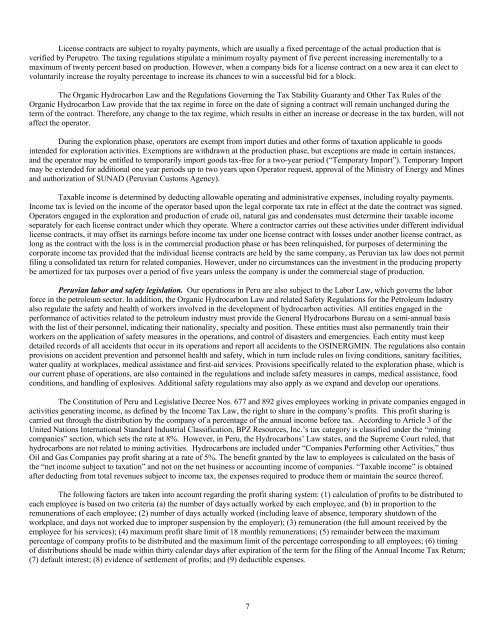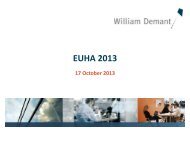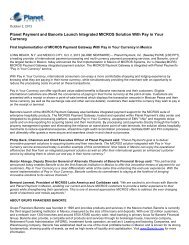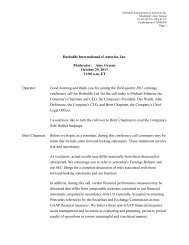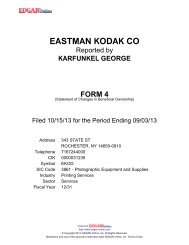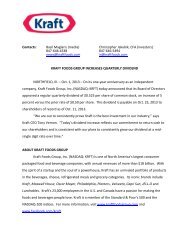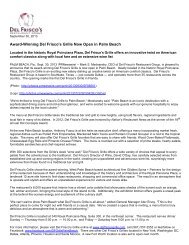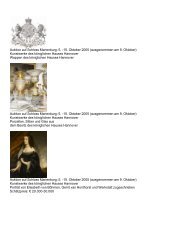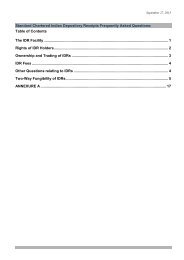BPZ Resources, Inc. - Shareholder.com
BPZ Resources, Inc. - Shareholder.com
BPZ Resources, Inc. - Shareholder.com
Create successful ePaper yourself
Turn your PDF publications into a flip-book with our unique Google optimized e-Paper software.
License contracts are subject to royalty payments, which are usually a fixed percentage of the actual production that is<br />
verified by Perupetro. The taxing regulations stipulate a minimum royalty payment of five percent increasing incrementally to a<br />
maximum of twenty percent based on production. However, when a <strong>com</strong>pany bids for a license contract on a new area it can elect to<br />
voluntarily increase the royalty percentage to increase its chances to win a successful bid for a block.<br />
The Organic Hydrocarbon Law and the Regulations Governing the Tax Stability Guaranty and Other Tax Rules of the<br />
Organic Hydrocarbon Law provide that the tax regime in force on the date of signing a contract will remain unchanged during the<br />
term of the contract. Therefore, any change to the tax regime, which results in either an increase or decrease in the tax burden, will not<br />
affect the operator.<br />
During the exploration phase, operators are exempt from import duties and other forms of taxation applicable to goods<br />
intended for exploration activities. Exemptions are withdrawn at the production phase, but exceptions are made in certain instances,<br />
and the operator may be entitled to temporarily import goods tax-free for a two-year period (“Temporary Import”). Temporary Import<br />
may be extended for additional one year periods up to two years upon Operator request, approval of the Ministry of Energy and Mines<br />
and authorization of SUNAD (Peruvian Customs Agency).<br />
Taxable in<strong>com</strong>e is determined by deducting allowable operating and administrative expenses, including royalty payments.<br />
<strong>Inc</strong>ome tax is levied on the in<strong>com</strong>e of the operator based upon the legal corporate tax rate in effect at the date the contract was signed.<br />
Operators engaged in the exploration and production of crude oil, natural gas and condensates must determine their taxable in<strong>com</strong>e<br />
separately for each license contract under which they operate. Where a contractor carries out these activities under different individual<br />
license contracts, it may offset its earnings before in<strong>com</strong>e tax under one license contract with losses under another license contract, as<br />
long as the contract with the loss is in the <strong>com</strong>mercial production phase or has been relinquished, for purposes of determining the<br />
corporate in<strong>com</strong>e tax provided that the individual license contracts are held by the same <strong>com</strong>pany, as Peruvian tax law does not permit<br />
filing a consolidated tax return for related <strong>com</strong>panies. However, under no circumstances can the investment in the producing property<br />
be amortized for tax purposes over a period of five years unless the <strong>com</strong>pany is under the <strong>com</strong>mercial stage of production.<br />
Peruvian labor and safety legislation. Our operations in Peru are also subject to the Labor Law, which governs the labor<br />
force in the petroleum sector. In addition, the Organic Hydrocarbon Law and related Safety Regulations for the Petroleum Industry<br />
also regulate the safety and health of workers involved in the development of hydrocarbon activities. All entities engaged in the<br />
performance of activities related to the petroleum industry must provide the General Hydrocarbons Bureau on a semi-annual basis<br />
with the list of their personnel, indicating their nationality, specialty and position. These entities must also permanently train their<br />
workers on the application of safety measures in the operations, and control of disasters and emergencies. Each entity must keep<br />
detailed records of all accidents that occur in its operations and report all accidents to the OSINERGMIN. The regulations also contain<br />
provisions on accident prevention and personnel health and safety, which in turn include rules on living conditions, sanitary facilities,<br />
water quality at workplaces, medical assistance and first-aid services. Provisions specifically related to the exploration phase, which is<br />
our current phase of operations, are also contained in the regulations and include safety measures in camps, medical assistance, food<br />
conditions, and handling of explosives. Additional safety regulations may also apply as we expand and develop our operations.<br />
The Constitution of Peru and Legislative Decree Nos. 677 and 892 gives employees working in private <strong>com</strong>panies engaged in<br />
activities generating in<strong>com</strong>e, as defined by the <strong>Inc</strong>ome Tax Law, the right to share in the <strong>com</strong>pany’s profits. This profit sharing is<br />
carried out through the distribution by the <strong>com</strong>pany of a percentage of the annual in<strong>com</strong>e before tax. According to Article 3 of the<br />
United Nations International Standard Industrial Classification, <strong>BPZ</strong> <strong>Resources</strong>, <strong>Inc</strong>.’s tax category is classified under the “mining<br />
<strong>com</strong>panies” section, which sets the rate at 8%. However, in Peru, the Hydrocarbons’ Law states, and the Supreme Court ruled, that<br />
hydrocarbons are not related to mining activities. Hydrocarbons are included under “Companies Performing other Activities,” thus<br />
Oil and Gas Companies pay profit sharing at a rate of 5%. The benefit granted by the law to employees is calculated on the basis of<br />
the “net in<strong>com</strong>e subject to taxation” and not on the net business or accounting in<strong>com</strong>e of <strong>com</strong>panies. “Taxable in<strong>com</strong>e” is obtained<br />
after deducting from total revenues subject to in<strong>com</strong>e tax, the expenses required to produce them or maintain the source thereof.<br />
The following factors are taken into account regarding the profit sharing system: (1) calculation of profits to be distributed to<br />
each employee is based on two criteria (a) the number of days actually worked by each employee, and (b) in proportion to the<br />
remunerations of each employee; (2) number of days actually worked (including leave of absence, temporary shutdown of the<br />
workplace, and days not worked due to improper suspension by the employer); (3) remuneration (the full amount received by the<br />
employee for his services); (4) maximum profit share limit of 18 monthly remunerations; (5) remainder between the maximum<br />
percentage of <strong>com</strong>pany profits to be distributed and the maximum limit of the percentage corresponding to all employees; (6) timing<br />
of distributions should be made within thirty calendar days after expiration of the term for the filing of the Annual <strong>Inc</strong>ome Tax Return;<br />
(7) default interest; (8) evidence of settlement of profits; and (9) deductible expenses.<br />
7


